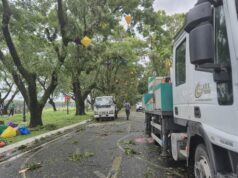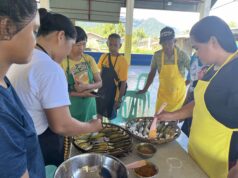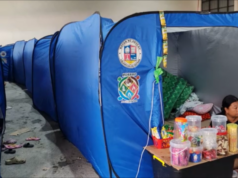Phalanx of Cabcom troopers strike at Nel Dizon.
MAY 3 is World Press Freedom Day. Declared by the United Nations General Assembly in December 1993 to raise awareness of the importance of freedom of the press and remind governments of their duty to respect and uphold the right to freedom of expression enshrined under Article 19 of the Universal Declaration of Human Rights.
Thirty years ago – on a May Day celebration – press freedom was bludgeoned, literally. Here is an account of that day as bannered in the May 2, 1990 issue of the Manila tabloid Afternoon HEADLINE, by-lined Bong Z. Lacson, president, Pampanga Press Club & chairman, NUJP-Pampanga:
Press freedom ‘slain’
CLARK SOLDIERS BRUTALIZE NEWSMEN
FREEDOM of the press died before the main gate of Clark Air Base yesterday, slain by soldiers of the Republic – those very people sworn to uphold and protect it.
In what has turned to be the most violent rally dispersal yet, Philippine Air Force troops assigned to the Clark Air Base Command swooped down, as a rampaging wave of truncheon-wielding horde, on the hapless rallyists; hitting at will at anyone regardless of age or sex.
Corazon Asuncion, 62, of Orion, Bataan, slapped and kicked. Elena Viray, fortyish, of Samal, Bataan, truncheoned inside a vehicle. Joel Baul, 20, of Guagua, Pampanga hit with a stone. There were also boys aged 8-12 hit with truncheons. A total of 85 rallyists remained unaccounted for up to late last night.
What brought a spine-tingling sensation among mediamen was the presence of a special force noted to have specifically picked on those wearing press tags and vests, methodically going about their job of bashing heads and breaking shins. Why this “special treatment” of mediamen?
In a press statement released immediately after the Clark melee, the Pampanga Press Club condemned “in the strongest terms the blatant assault on press freedom… and holds Brig. Gen. Demetrio Camua, Cabcom deputy commander, responsible for this barbaric act.”
To the press corps, yesterday’s assault was the “culmination of the systematic harassment of mediamen by Cabcom that started with the coming to the base of General Camua.”
The local media have been vocal about perceived irregularities at Clark, allegedly involving Cabcom troopers. Alleged carnap syndicates, the mess in the garbage disposal contracts, widespread theft and robbery, and the “illegal detention” of 32 heads of cattle by Cabcom soldiers have been staple news in many local publications as well as in correspondents’ stories in the Manila papers.
It was after these stories found their way in the papers that mediamen covering rallies at Clark started getting hurt. First was Robledo Sanchez of Manila Times. Then came Sotero Chandler Ramas III of Daily Globe. Yesterday’s list grew longer: Norberto Quito, Philippine Star, with 12 stitches on a head wound; Renel Dizon, Philippine Weekly Graphic, contusions and abrasions in various parts of the body; Eric Jimenez, Angeles Sun, truncheoned; Noel Vizcocho, Manila Times, and Jun Dimaging, Bagong Pinoy, both missing until late last night, last seen being mauled by Cabcom soldiers; and again, Ramas and Sanchez.
“Camua and his running dogs have become the scourge not only of peaceful demonstrators but also of mediamen. The earlier they leave Clark, the better for us all,” said Fyodor Fabian, spokesman of the National Union of Journalists of the Philippines-Pampanga.
THE AFTERMATH. Both the NUJP and the National Press Club with its president Marcelo Lagmay provided all the legal, material and moral support to the PPC struggle for justice for Quito and the others. A symposium was held at the NPC to rally national attention to the case.

The Quito mauling too spurred the first – and so far, only – media rally in front of Clark Air Base, participated in by some 200 Pampanga and Metro Manila mediamen including notables, NUJP chair Antonio Ma. Nieva; Atty. Ric Valmonte, president of the Philippine Movement for Press Freedom; and Rep. Oscar S. Rodriguez (3rd District-Pampanga). The rally was covered not only by the national media but also by the international news services Reuters, Associated Press, Agence France Presse, United Press International, Kyodo and Cable News Network.
Breaking through a military cordon, the media protesters achieved a historic first: the occupation of Clark’s main gate where no other group of rallyists ever came as close. Their streamers said it all: “Save Media, Oust Camua, et al.”
In what could have been a reversal of roles – as observed by a foreign correspondent – the protesting mediamen found themselves being covered – for protection – by policemen and Constabulary troopers with no less than their chiefs directing operations – Angeles Metrodiscom chief Col. Julius Yarcia and PPC-INP Recom 3 commander Brig. Gen. Manuel Bruan.

The House of Representatives too formed a committee to investigate the incident. As PPC president, I was among the principal resource persons at the hearings held by the joint committees on information and human rights chaired by Rep. Michael Mastura. Among the congressmen who immediately denounced Cabcom’s “system of aggression against the media” were Bonifacio Gillego, Venancio Garduso, Gregorio Andolana, Charito Plaza, and of course, Oscar Rodriguez.
The joint committees found the evidence we presented particularly damning: actual photographs of the mauling of Quito, Dizon and others, and the handkerchief-covered faces of their tormentors which Elmer Cato, Angeles Sun publisher and Manila Chronicle and Kyodo correspondent, painstakingly collated and documented. My question to the Cabcom officers present, “Since when did hankies-on-faces become part of the Air Force uniform?” provoked Gillego to denounce Cabcom as no different from robbers and highwaymen.
(From Chapter 3 – Waging War – of my book Of the Press (1999))





